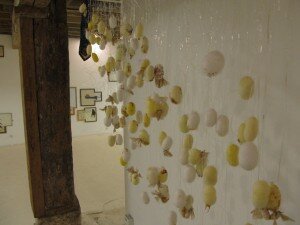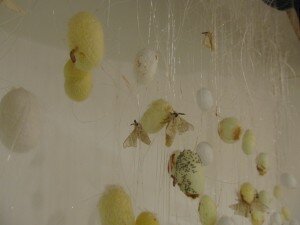Joanna Rose Tidey - "DOM"
Posted on November 28, 2011
Joanna Rose Tidey - DOM"
My interest lies in the way in which we try to control the natural world around us for both work and pleasure. Many people are removed from the origins of objects we use every day, so caught up in our own existence that we do not see past our own needs.
Silk is a primary example of this. Many people not knowing whether silk is made from animal, plant or mineral. The silk industry originated in China who monopolised the industry for thousands of years. There are some beautiful stories that surround the evolution of sericulture. However within these beautiful stories and textiles produced is entwined a darker side with links to economy and jealousy, domestication and complete reliance on mankind.
We get up in the morning and get ready for the day- many of us putting on a silk tie for work. It takes an average of 110 little lives to produce enough silk for something you wouldn't think twice about putting around your neck.
110 cocoons spun by 110 worms, which start out as tiny eggs, the size of a pin head. These eggs, first yellow then gradually if fertilised turning a slate grey. After being put into wintered conditions they are then brought up to the right temperature and humidity, hatching within 7 days.
For 3-4 weeks they spend their time eating their way through mulberry leaves- white being preferred choice to the courser black mulberry leaves. However failure in getting fresh, artificial is also available- silkworm chow, which is powdered mulberry leaves you add water to and microwave!
Four weeks of constant eating, 5 instars later, the lethargic, fleshy, plump worms; the sizes of my index finger loose their appetite. They spend on average 3 days constructing their temporary home from one single strand of silk. They perform what looks like a dance (a figure of eight around their body) encasing themselves with the silk secreted from glands near their mouth parts. Once encased, they go through their transformation which takes on average of 2-4 weeks depending on temperature.
However in the silk industry only a lucky few get to live out their full life cycle to continue the race. For the rest, this is where their life ends. The alkali they secrete to emerge out of the cocoon breaks the single strand of silk. Therefore they get exposed to high temperatures of steam which kills them at the pupae stage of their lives.
The moths in this installation, started off as worms, which I nurtured. They have been able to emerge and live out their full life cycle- unlike those in the silk industry.
These insects were hybrid from the wild silk moth- however this breed (Bombyx Mori) are unable to live outside of manmade conditions. They cannot fly and have no immune system. They are completely dependent on the hand of mankind for survival.
The silk trade has many connotations to the female form, the Goddess of silk- Hsi-Ling-Shih and textiles being a predominant female occupation. I wanted to relate the silk production with the tie- it is a item of clothing relevant to today that is worn by those professionals whose career is in economy and science- with "Domestication" , the "DOM" (abbr. to God) of a life for production value- like that of the silkworm sweat shop workers.
Thanks goes to William from Naturally Inspired Silk Farm for his support of my work.
By Joanna Rose Tidey
Photos taken by Natasha Williams
Joanna's work is currently on display at Curious Duke Gallery as part of the group exhibition Extension untill 15th December.



